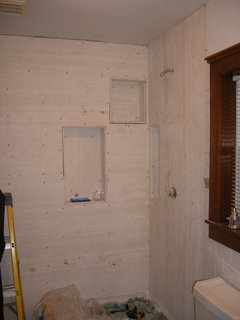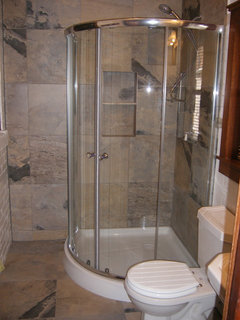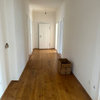epoxy or marine paint over greenboard for my shower walls (not tile)
Kommentare (91)
delyanks
vor 9 JahrenGreenboard isn't even used here around tubs anymore. Many mold issues. I'd feel much more comfortable using cementboard and painting it.Niagara Remodelling
vor 9 JahrenZuletzt geändert: vor 9 JahrenI just want to clarify that I am not recommending the use of Green board drywall. The product that I listed is named Green-E-Board. It is NOT a gypsum based product. The lumber yard that I purchase from has a piece submerged in water since 2008. You can take it out and handle it. It is still solid. I prefer it over cement board. I should also make it clear that I am not advocating the use of paint as a waterproof solution in a shower. I simply recommended this product in answer to the original post, because it is not affected by moisture, and it has a smooth side that finishes easily. The link to the product and it's technical details is - http://www.greeneboard.com/index.html
The wall sheathing in the photos is the Green-E-Board with the rough side out. Not shown.. I took the overkill approach and applied Red Guard over the sheathing before tiling.


winstonfiore
vor 9 JahrenGreat thread. I'm new to Houzz and would like to receive a notification every time someone new posts to this, so I'm leaving a comment.Ian Temple
vor 9 JahrenI have a 1 1/2 storey house and am in the middle of a bathroom reno. The ceiling over the tub slopes down from the shower side to the back of the tub. This means that there is waterthat splashes on the ceiling. The ceiling has been insulated, vapour barriered and greenboard put on. The shower surround has been done with densshield tike backerboard. Im wondering if you guys think that painting the ceiling with a marine paint or epoxy would be a bad idea?griepentrog
vor 9 Jahreni want a 'smooth wall finish' look as well in my shower and i came across this on houzz......
Modern Bathroom by Seattle Architects & Building Designers chadbourne + doss architectsTeresa
vor 9 JahrenRe: Marine Paint... if it's toxic to marine organisms (and much of it is) then it's probably not the best idea to use it in a place where you regularly disrobe and stand in water that has had contact with the paint. Be safe!
I came on this site because I, too, have a old shower with an ugly tile floor and "seems-to-be" plasterboard painted walls. I repainted the walls a number of times but it only lasts a few years before it starts cracking/peeling in places (just a little though). The tile is not damaged, just ugly. Painted it too and now – 4 years later - the paint is peeling again and it looks pretty bad (and very mildewed).
Thanks for all the great ideas!ian_bramall
vor 8 JahrenMy parents had a plaster wall shower painted, I assume marine paint, the floor pan was tile, it was built in 1964 and was repainted every 10 years after scuffing the paint surface. I do not know what is under the tile but it was sealed and the tile is up the wall about 4-5 inches from the floor. It is now 50 years later and there has never been a leak from the floor. Only now 50 years later there is a small amount bubbling in the paint low down. I think this is because they failed to keep up with the painting because the are now in their late 80's. I am pretty sure that if they had kept up the painting it would still be fine. I am sure that you can not go down to your home reno store and buy paint to do this and it probably will not pass current day building codes. I am sure that the marine paint went all the way down the wall and then the 4 - 5 inches of tile up from the floor was put on over the paint. The top of the tile was sealed with silicone. The tile was all grouted and the tile and grout was sealed.
Brian Curley
vor 8 JahrenZuletzt geändert: vor 8 JahrenThis thread is classic "old school contractor" vs "new school DIYer". Old school contractors only know the way its been done and disagree with anything that goes against that. New school DIYer has the internet at its disposal and can research every aspect of any application. I did some research and used a flexible epoxy made for boats and applied it as a flooring material in my bathroom in lieu of tile. Pretty much every contractor i spoke to said it wouldnt work but it has. The problem with contractors is that unlike other professionals (doctor, lawyer, accountant, etc.), they fail to read/keep up with modern developments and rarely think outside the box.
As far as this application goes, keep in mind that epoxy doesnt apply well to walls (thixtrophy?) and will yellow if exposed to sun. I'm thinking the marine paint is the way to go as they've been specifically designed for a similar use.
User
vor 8 JahrenAccording to the spec sheet on Durock, you should not paint it at all because Durock is meant to develop microcracks as things settle and the paint will crack with it. I wanted to do the same thing, but I have become convinced to do ceramic tile over Hardiboard around my shower stalls.
S. Thomas Kutch
vor 8 JahrenLike Brian said this is old school vs. thinking outside the box. Everyone has their valid points and it seems that the solution is going to be in the details. True, tile on green board is a disaster just waiting to happen, we all know this. Heck, I've replaced many a shower where Durock was used as the backer board with tile over it that still involved replacing rotted sill plates, studs and sub-flooring. Unfortunately, there is no substitute for quality and craftsmanship of installations be it tile, fiberglass panels., glass, etc., etc.. I'm sure the idea of the OP is possible, given the proper attention to the details and the installation. I once stayed in a 200+ year old villa in Rome where the shower was Venetian Plaster walls over bead board. The base and the corner joints were all coved and the owners told me that their great grandfather had done the renovation work back in the 1800's. The appearance looked like marble. The only thing they did to it was give it a hand rubbed coating of carnauba wax every year......something passed down from their great grandfather.
I would suggest that the OP do his research and pay particular attention to the details of his joints, separations and movement issues. Personally, I would lean more to something like a Densglass backer board with silicon impregnated gypsum and a fiberglass sheathing in lieu of anything with a cellulose based sheathing.....but that's just me.Kivi
vor 8 JahrenNot sure what kind of crappy contractors Brian is working with but I can tell you there are many contractors who spend a great deal of time to understand building science, and getting to know new products. I'm sure not all do, but I think thats true for all professions. The reality is that there are fundamental steps one needs to pay attention to with most projects. There are countless threads on houzz about failed shower installs, and the causes are almost always a lack of understanding or not paying proper attention to the steps needed for a lasting installation.
In this case lets assume the original poster creates a perfectly waterproof membrane with the marine paint (or whatever paint he chooses to use). He now has a shower that has a waterproof layer that is the thickness of paint... which also acts as the wearable surface of the shower itself. If at some point (sorry... when) this layer fails even slightly, there is no backup protection and the greenboard (which should not be there), begins to turn into a soggy mess.
I certainly would not want a shower in my home with such a high risk level of failure.
Andrea Little
vor 8 Jahreni was just telling a coworker about 5 mins ago how i wanted to do this exact same thing... i am so glad i happened upon this thread! now did you actually do it Ricardo Soares?
richard jeffries
vor 8 JahrenI have a epoxy shower room - osb board over stud work, then bathroom membrane boards, then full membrane tape and membrane paint over all joints, then 2 cm exterior grade plaster, then epoxy primer and then 3 coats of swimming pool white epoxy paint - mapei - this will last for years and years - like a swimming pool!Ironwood Builders
vor 8 JahrenIt was, with some wry amusement that I re-visited this post. I had nothing to add the first time. I'm what Brian, above, calls, with some disparagement, an old school contractor. I say that because...I'm old. I went to school. It was and still is the school of hard knocks. I spend hours and hours of my time learning the most I can about better products and better practices...in order to put them to use. I've torn apart and fixed every lame brained attempt at building you can imagine..and some you can't. The difference between a contractor, old school, in the box...or creative thinker, willing to listen...and ANY DIY'er is that we do it for a living. Our mistakes, well intentioned or not, cost money, our money. Lawyer money. So when you come up with a really cool cheap way to do stuff, try it out and when the house starts falling down, call someone like me to fix it...be prepared for the pain we feel every time there is a call back. There is a really "old school" way to avoid screwing up and spending a lot more money to fix something done wrong. It's called "read, watch, do". If the experiments suggested by the OP, so logically addressed by Kivi, also above, worked for more than a year, I'd be interested to hear it. Thing is...we contractors only grudgingly let water into the house in tight fitting pipes...it is our ENEMY!richard jeffries
vor 8 Jahrenour epoxy shower room has been made in conjunction with Mapei - they know what they are doing :)
martin miller
vor 8 JahrenHi, i just stumbled upon this....
but anyone wanting to have an equiv. to tiles in a wet room environment may wanna check this out (and is at it says, the oldest form of wet room application, over 4000 years ago it was being applied! - good enough for the Romans? - we are also old school... very old school.... don't think you'll get much older than 4000 years!!) enjoy reading and good luck!
davidrupp00
vor 8 JahrenWe are considering using marine paint on the drywall of a shower. It's an old house, and the previous owner just used regular waterproof paint on it. A few months after moving in and using the shower, the walls started to crack. We can't afford much, and aren't DIY types. We've repaired the cracks. A marine/pool paint seems like the best solution just to get this under control for now.
Melissa Jane
vor 8 JahrenRicardo - you still enjoying life? Curious to see if you tackled your project. I'm about to tackle a small shower stall. It will be a temporary shower until we are able to do some larger renovations. Going to try cement board, waterproof plaster and marine paint. My goal is temporary fix for low cost. Really intrigued by tadelakt but we have a very small space so maybe I'll consider for final renovation.
User
vor 8 JahrenAvoid the question and install a one piece acrylic shower stall that has a continuous shell everywhere including the stall ceiling. While your at it choose a no-threshold handicapped approved shower stall like the Kohler unit I installed. Anybody (young or old) can use it so why don't builders install them in new house construction? Probably to save money, but you end up dealing with all the problems referenced above for non-waterproof shower stalls.
Katbv Vero
vor 8 JahrenI would get friendly with a marine mechanic, he might be able to give you a few tips, as well.poppdaddy
vor 8 JahrenPoppdaddy, Starting a reno on a small bathroom with a shower. The shower walls were tiled over drywall, joints cracked and mildew developed. We tore out the old shower and replaced it with cultured marble from a business who manufactures and installs their product. We replaced both the floor pan and walls. We now want to install a drop ceiling. The ceiling squares are made of plastic, and we feel it will give a more finished look to a newly remodeled bath and hide the old, ugly ceiling. My question is, under the new drop ceiling is drywall (old ceiling), is it necessary or not, to waterproof the old ceiling, and if we should waterproof, should I waterproof the whole ceiling or just the area above the shower ? Thanks, any input would be greatly appreciated.
Kivi
vor 8 JahrenPopp, you are better off starting a new thread instead of adding on to an old one, particularly this misguided thread.
As to your concerns, no you don't typically need to waterproof the ceiling of a shower ( a steam shower is a different story). However, your plan to put some plastic tiles on the ceiling is a bit of an oddity. You don't describe them, or the method you are using to mount them, but I would say the following. I would not want to mount plastic tiles in such a way that they allow the possibility of steam vapour getting behind the tiles, condensing, and then staying damp for extended periods. Even waterproofing behind such an installation would not change my mind about wanting such an install.dottt1
vor 8 JahrenI want to do something similar to what you are talking about and am searching for tile alternatives. The only really safe thing I can come up with is to finish the walls with a good quality gloss paint such as Auro that isn't toxic (the shower should be a very clean, non-toxic place). Then install a shower pan over the walls (not flange behind the sheetrock) and use some sort of rubber edging to seal (maybe peel and press cove base?) and install a ceiling suspended shower rod and be surrounded by the least toxic shower curtain available. You would still be free of tile (I HATE tile/grout), but your walls would be protected by the curtain when you shower. When the curtain is dry, you could still have a very open room. Those ceiling hung rods (like for clawfoot tubs and free-standing claw foot shower pans) can be rectangular and large enough to still give you that walk-in shower experience. By the way, I think those shower stalls that have you put up acrylic walls behind sheet rock are stupid. Sooner or later they are going to crack, then you have to rip out your sheetrock! Ridiculous. Also, it is infuriating that free-standing shower bases are available all over the world but apparently not in America. All I can find here are the types with flanges. Why the heck does everything have to be so darned complicated?!?
Cancork Floor Inc.
vor 8 Jahren@dottt1...the complication begins when you try to work around the "basics". I've seen acrylic liners and they rarely crack (I've owned many and only 1 cracked = after a fight between rugby players ended in the bathroom with a trip to ER and a head injury = cracked acrylic liner).
Trying to stay away from "toxic" stuff is going to lead to some of the most dangerous materials growing in the bathroom: black mould. I know you are trying to stay away from all of the nasty stuff, but some of the best materials are ceramic/porcelain tile that is properly grouted laid over properly prepared cement board.
Complications arise when standard operating procedures are replaced with complicated "options" that do not offer the same amount of protection as the original product.
I've seen the European claw foot tub with the wrap around vinyl curtain and rod. The entire bathroom was STILL tiled. The areas of paint that were too close = bubble and pealing = flaking paint = costly repair.
Complications arise because water proofing a bathroom is complicated. It is. There is no two ways about it. Shower walls cannot be water "resistant"...(like a painted surface) but water PROOF (like tiles/grout). The complications begin because of the situation. Add in a "different approach" and you have double the complications with triple the mess.
I hope you find what you are looking for. Acrylic liners (assuming you have no on who tries to put their head through the wall) will work just fine.
alijmac
vor 8 JahrenI recently came across this product - no personal experience with it, but it looks beautiful. Not sure how expensive it is though http://www.rockcote.com.au/products/marrakesh
dottt1
vor 8 JahrenThis discussion was very helpful. After weighing the pros and cons of tile, lime plasters, solid surfaces, etc., I have decided to do away with the walk-in shower altogether and use the roman tub that is already there. With the help of a new faucet set-up that includes a hand shower, the roman tub will be both shower and tub. The walk-in shower will be a separate room with a toilet and sink. This enables me to get rid of the double vanity in the bedroom and replace that with a row of clean, neat cabinets with a solid surface top. Always hated sinks in the bedroom and storage crammed in with sink plumbing. Also, so much more practical and sanitary to have the sink next to the toilet. Will never have to worry about walk-in shower failure again nor have to resort to a flimsy shower enclosure. This will save loads of money, too. Should have done this years ago! The best part? NO GROUT! And a minimal amount of caulk. Am half way through and will come back and load pictures when it is completely done.
Eleanor Moffat
vor 7 JahrenI am planning a similar job to Riccardo but only need the paint on the walls, not the floor. How did you Riccardo.... Loving this thread.pqtex
vor 7 JahrenI realize this is an old thread, but I have done something similar to what the original poster was trying to accomplish. I used Redguard waterproof membrane over the existing wall and kitchen and bath paint on the walls behind my tub/shower. I live in a century-old farmhouse. The bathroom was added in the 1950's. The walls of the entire bathroom, including around the tub, are wall board that is scored supposed to look like tile. It comes in 4'x8' sheets. It runs horizontal, 4 ft, like wainscoting. The upper walls are sheetrock. I don't know if they used water resistant sheetrock or regular. The meeting place and joints are covered by metal edging. I have no budget and few construction skills. This was a tub, but I also wanted a shower. And I also wanted the room to look nice. I used Redguard from Home Depot. I applied it to the wall board and the sheetrock above the wallboard and I also painted the ceiling with it. I followed the instructions carefully. After it was ready, I painted the entire room. I don't recall the exact paint I used, but it was Sherwin Williams, probably kitchen bath gloss, may have been oil based, but I really don't remember now. It has been over 10 years, and it has been very successful. This is the only bathroom in the house and it is used daily for multiple showers by the family. This was supposed to be a temporary measure until I could afford a bathroom remodel, but it has worked. Periodically I have to recaulk at the horizontal edge between the wallboard metal strip and the tub and vertical corners just like you do with any other bathtub. There is a very faint line of demarcation between the tub and the rest of the room where I ended the use of the redguard due to the thickness of the redguard under the paint, but it isn't very noticeable. I hope this helps anyone else who is looking for information. Obviously this isn't the choice for someone with the budget to actually remodel a bathroom. However, if you are looking for a low-to-no budget DIY fix for sprucing up a bathroom and you don't have much money to spend, this method did work, it has worked, and it is still working...and the shower is fully functional...and waterproof.
jefferson17
vor 7 JahrenGreen or purple board in a shower is a definite no-no. For all the reasons previously stated - at some point, if moisture gets back there - from either side, the wall will fail. For not much more money, you can put up any number of PROPER backerboard products (that don't care about moisture) and paint them with hydroban or redguard to waterproof the surface. Then just tie the walls into either a pre-made pan (cheapest) and you'll have a solution that will last. You'll then coat the walls with some type of waterproof paint - if the paint needs to be touched up every so often it's not a big deal but the SUBSTRATE will be rock-solid.
Honestly, the end result would be IMO pretty ghetto. You'd be better off using inexpensive ceramic subway tiles as a finish, with a complementary grout. Say white tiles and grey grout - classic and clean looking. And easy to do. The whole thing could be tiled in a single day.Another inexpensive way to do those walls i just use install sheet vinyl sheets instead of tile.
Bear in mind that the bathroom will simply look cheap if you do anything other than tile, and when you eventually sell your house it'll negatively impact your ability to sell. A really nice tile job adds value and gets buyers to WANT your house. You can get really NICE natural stone tiles for only $2.5-3.5 a square foot. Bathrooms and kitchens aren't places to skimp ...Shannon Riordan
vor 7 JahrenHello. I wonder if Ricardo did this? We have a small bathroom/ wet room which will rarely be used - on occasion by guests so we think the marine paint will do fine. Any word?
randolphwild
vor 7 JahrenLast post was on my birthday so it seems appropriate to post on this thread. We live in Australia and are going through the same thought processes as above. We have decided to first apply waterproofing to a marine ply lining. On top of this we have fixed Villaboard, water proof fibrecement. We were going to finish this with Tadelakt, a water resistant render but we were not confident of getting a good finish so we are now going to apply tile paint and place aluminium trims to the edges. If this is not a success, I cant imagine it leaking because of the waterproof membrane and only the finish might fail, we might line it with thin sheets of galvanized steel. We like the industrial look.
Lacy Flavell
vor 7 JahrenSo This thread started so long ago you are probably finished with your project now. However, my two cents, rather than green board use hardie-board. You can go one step further and get the exterior panels. They come in a wide variety of colors (ie: no painting) and a few different textures. You could do a tub surround with 2-3 panels. $70-$110. Then, just use molding to finish the edges...or if you start at the studs find a way to blend it with the drywall.
Debbie Mankelow
vor 7 JahrenPopping my head above the parapet once more, I posted way back about my epoxy painted shower walls, which I intend to do agin in my new house. I have recently installed a new kitchen and finished the countertops and the backsplash with white Microcement which in itself is waterproof but I have also sealed them with an epoxy varnish. The supplier http://www.microcement-supplies.co.uk assured me that this is also suitable for shower walls and is a totally waterproof solution, much like venetian plaster. However as many have pointed out it depends what base you are putting it on top of, most of the wall in my house are brick and plastered so they provide a stable substrate. I'm always being told that " you can't do that! " but with some diligent homework you often can.
Shiner Hurley
vor 6 JahrenHas anyone tried BREAKTHROUGH over dated but good conditioned tiles instead of drywall.? Marine paint???C A nash
vor 6 JahrenLacy's suggestion seems like the perfect solution: prefinished outdoor cement board. Does anyone see a downside to this?
Eleanor Moffat
vor 6 JahrenSo we finished our bathroom with a new waterproof membrane on the walls. It's a super think waterproofer that we slightly water downed until it was a consistency of paint. We used a paint primer first (tinted the same colour as the waterproofer) then used 3-4 coats of the waterproofer. Also added an anti mould solution to the primer. Had it signed off by our surveyor who was amazed by it. I'll try and send some photos.
Eleanor Moffat
vor 6 JahrenI didn't get any photos of the shower properly. But you can see in the mirror that the shower is attached to the wall with the waterproof membrane behind. Basically the whole bathroom is a wet room now.
ilikefriday
vor 6 JahrenZuletzt geändert: vor 6 JahrenEleanor - I love your shower! What a fabulous job. My shower was completely tiled and waterproof but I hated the tile. I covered the tile with canvas and painted the canvas with wax. I think your idea may have been easier.
Debbie - Not sure if you are still around but can you post photos of your epoxy coated shower? I too like to prove people wrong when they say something cant be done.
deciduousconifer
vor 4 JahrenEleanor Moffat, do you have the names of the specific products you used? I want to do this, too.
Eleanor Moffat
vor 4 JahrenIt‘s been about 18 months since we renovated the bathroom and the paint is holding up well - no bubbles, cracks or discolours. It’s a very heavily used bathroom (2 adults and 2 kids use it daily). I’ll double check the name of the products and let you know shortly.
Eleanor Moffat
vor 4 JahrenWe used a standard grey colour waterproof membrane watered down to a thick paint like consistency. And applied 4 coats.
Darwin Sango
letztes JahrYou could use marine grade plywood, apply a coat of flexible epoxy primer, epoxy, and then a couple of coats of polyurethane or additional clear epoxy as a protective coat. Roll on epoxy isn't as durable as two part epoxy, but polyurethane can help protect it and can even be used on acrylic paints to protect them.

Laden Sie die Seite neu, um diese Anzeige nicht mehr zu sehen





David Muench